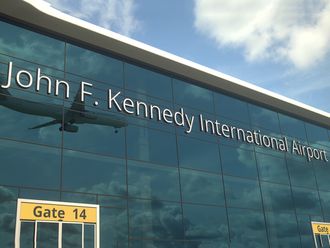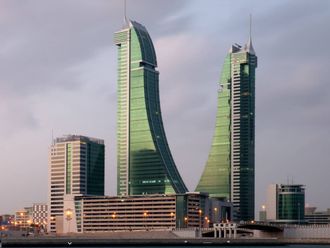Manama: US long-term military commitment to Bahrain and the region has been reiterated by a senior officer who said that they looked forward to a bright future.
“The US Navy has been here since 1948,” Rear Admiral James Loeblein, Deputy Commander, US Naval Forces Central Command, said. “We have been here for over sixty-three years and we look forward to a nice, long time in the future as well,” he told Bahrain News Agency (BNA) at the Bahrain School Falcons Alumni open house and reception.
Admiral Loeblein said that US Navy personnel “loved to come to Bahrain and to serve” and to send their children to Bahrain School.
“These are the sons and daughters of our sailors and soldier servicemen and women in the marines. They love to serve and they love to come here to school to have a great world-class education in a world-class school,” he said.
The Bahrain School reception was hosted as part of the celebrations of the American-Bahraini Friendship Week.
Unlike at times conflicting statements issued by politicians, the declarations made by military commanders have been very clear about the depth of the US Navy engagement with the region.
Last month, Vice Admiral John Miller, the commander of the 5th Fleet and the US Naval Forces Central Command, said that US Navy operations in the Arabian Gulf would go well into the middle of the century.
Referring to the $580 million base expansion in Bahrain that includes modifications to accommodate the US Navy’s new littoral combat ships (LCS), due to be operational in the Arabian Gulf by 2018, Vice Admiral John Miller said that it indicated “an enduring presence.”
“Some of the modifications that we are doing right now will help us get the base ready for the arrival of the littoral combat ships, which will start right around 2018,” Miller told Defense News. “Those are ships that will serve in the US Navy and this area right until the middle of the current century. We would not plan for this infrastructure if we did not plan on staying here and the second thing is that we plan on staying not just as the US Navy but in a coalition environment,” he said.
In February, Rear Adm. Kevin Sweeney, commander of the Harry S. Truman Carrier Strike Group, said that the US was committed to Bahrain and the region.
“We have a full commitment to this area,” Sweeney said. “Our presence in the region is a continuation of six-decade long commitment to stand by our partners in the region and we’ll continue to honour that commitment. “A big part of what I do out here as the Harry S. Truman Carrier Strike Group Commander, in addition to helping protect the free flow of commerce, is to build trust and inspire confidence with our regional partners,” he said.
An enduring US presence in the region strengthens the US bond with regional partners, he added.
The US Navy has had “a continuous presence in the region for more than 60 years and continues to work with its regional partners day in and day out to enhance security and stability and build trust and confidence.”
“Our Navy is committed to maintaining a sustainable defensive presence in support of our regional partners, providing the flexibility to react to crises, and safeguard the free flow of commerce in waterways to enable the global economy.
“Our deployment demonstrates our long-standing commitment to the stability of the region. I first came to this region and Bahrain as a young lieutenant back in 1990, and I cannot say enough about how well the Bahrainis embrace and support our Sailors,” he told Gulf News aboard the Truman in the Sea of Oman.
Sweeney, 54, said that the deployment had been highly useful in several ways.
“It demonstrates the long-term commitment the US has to the security and stability of the region. And as you have seen firsthand, after being forward deployed for seven months now, I continue to be amazed at what our young motivated Sailors and Marines accomplish each and every day,” said Sweeney who was responsible for USS Cole’s restoration and return to fleet operations in April 2002.
The size of the region, however, remains the greatest challenge the Navy has to face.
“The 5th Fleet area of responsibility covers a vast volume of water space and airspace to include the Red Sea, Gulf of Aden, the Arabian Sea, the Sea of Oman and of course the Arabian Gulf,” Sweeney said.












